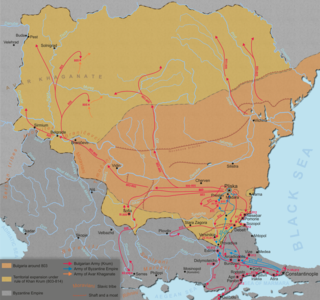The 800s decade ran from January 1, 800, to December 31, 809.
The 780s decade ran from January 1, 780, to December 31, 789.
The 770s decade ran from January 1, 770, to December 31, 779.

Year 807 (DCCCVII) was a common year starting on Friday of the Julian calendar, the 807th year of the Common Era (CE) and Anno Domini (AD) designations, the 807th year of the 1st millennium, the 7th year of the 9th century, and the 8th year of the 800s decade.

Year 806 (DCCCVI) was a common year starting on Thursday of the Julian calendar, the 806th year of the Common Era (CE) and Anno Domini (AD) designations, the 806th year of the 1st millennium, the 6th year of the 9th century, and the 7th year of the 800s decade.

Year 803 (DCCCIII) was a common year starting on Sunday of the Julian calendar.

Year 802 (DCCCII) was a common year starting on Saturday of the Julian calendar, the 802nd year of the Common Era (CE) and Anno Domini (AD) designations, the 802nd year of the 1st millennium, the 2nd year of the 9th century, and the 3rd year of the 800s decade.

Year 782 (DCCLXXXII) was a common year starting on Tuesday of the Julian calendar, the 782nd year of the Common Era (CE) and Anno Domini (AD) designations, the 782nd year of the 1st millennium, the 82nd year of the 8th century, and the 3rd year of the 780s decade. The denomination 782 for this year has been used since the early medieval period, when the Anno Domini calendar era became the prevalent method in Europe for naming years.

Abū Jaʿfar Hārūn ibn Muḥammad ar-Rāshīd, or simply Hārūn ibn al-Mahdī, famously known as Hārūn ar-Rāshīd, was the fifth Abbasid caliph of the Abbasid Caliphate, reigning from September 786 until his death in March 809. His reign is traditionally regarded to be the beginning of the Islamic Golden Age. His epithet al-Rashid translates to "the Orthodox", "the Just", "the Upright", or "the Rightly-Guided".

Staurakios or Stauracius was the shortest-reigning Byzantine emperor, ruling for 68 days between 26 July and 2 October 811.

Abū ʿAbd Allāh Muḥammad ibn ʿAbd Allāh al-Mahdī, better known by his regnal name al-Mahdī, was the third Abbasid Caliph who reigned from 775 to his death in 785. He succeeded his father, al-Mansur.
Michael of Synnada or Michael the Confessor was a metropolitan bishop of Synnada from 784/7 to 815. He represented Byzantium in diplomatic missions to Harun al-Rashid and Charlemagne. He was exiled by Emperor Leo V the Armenian because of his opposition to iconoclasm, and died on 23 May 826. He is honoured as a saint by the Eastern Orthodox and Roman Catholic churches, his feast day is May 23.

The Battle of Krasos took place during the Arab–Byzantine Wars in August 804, between the Byzantines under Emperor Nikephoros I and an Abbasid army under Ibrahim ibn Jibril. Nikephoros' accession in 802 resulted in a resumption of warfare between Byzantium and the Abbasid Caliphate. In late summer 804, the Abbasids had invaded Byzantine Asia Minor for one of their customary raids, and Nikephoros set out to meet them. He was surprised, however, at Krasos and heavily defeated, barely escaping with his own life. A truce and prisoner exchange were afterwards arranged. Despite his defeat, and a massive Abbasid invasion the next year, Nikephoros persevered until troubles in the eastern provinces of the Caliphate forced the Abbasids to conclude a peace.

The Abbasid invasion of Asia Minor in 782 was one of the largest operations launched by the Abbasid Caliphate against the Byzantine Empire. The invasion was launched as a display of Abbasid military might in the aftermath of a series of Byzantine successes. Commanded by the Abbasid heir-apparent, the future Harun al-Rashid, the Abbasid army reached as far as Chrysopolis, across the Bosporus from the Byzantine capital, Constantinople, while secondary forces raided western Asia Minor and defeated the Byzantine forces there. As Harun did not intend to assault Constantinople and lacked ships to do so, he turned back.

The 806 invasion of Asia Minor was the largest of a long series of military operations launched by the Abbasid Caliphate against the Byzantine Empire. The expedition took place in southeastern and central Asia Minor, where the two states shared a long land border.
Al-Qāsim ibn Hārūn ar-Rāshīd ibn Muḥammad al-Mahdī was an Abbasid prince, the third son of the Abbasid caliph Harun al-Rashid, and for a time third-in-line to the Abbasid throne.
Khuzayma ibn Khazim ibn Khuzayma al-Tamimi was a powerful grandee in the early Abbasid Caliphate. The son of the distinguished military leader Khazim ibn Khuzayma, he inherited a position of privilege and power, and served early on in high state offices. He was crucial in securing the accession of Harun al-Rashid in 786, and was an influential figure throughout his reign. During the civil war of 811–813 he sided with al-Amin, but finally defected to the camp of al-Amin's brother al-Ma'mun and played a decisive role in ending the year-long siege of Baghdad in a victory for al-Ma'mun's forces.
Ḥumayd ibn Ma'yūf al-Ḥajūrī was an Arab commander in Abbasid service in the early 9th century.
Sa'id ibn Salm al-Bahili was an Arab governor and military commander of the early Abbasid Caliphate.
Abu Sulaym Faraj al-Khadim al-Turki, sometimes erroneously called Faraj ibn Sulaym, was an Abbasid court eunuch and official.









